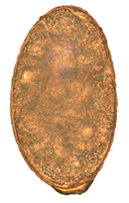| Nanophyetus | |
|---|---|
| Scientific classification | |
| Domain: | Eukaryota |
| Kingdom: | Animalia |
| Phylum: | Platyhelminthes |
| Class: | Trematoda |
| Order: | Plagiorchiida |
| Family: | Troglotrematidae |
| Genus: | Nanophyetus Chapin, 1927 |
| Species: | N. salmincola
|
| Binomial name | |
| Nanophyetus salmincola (Chapin, 1926) Chapin, 1927
| |
| Synonyms | |
| |

Nanophyetus salmincola is a food-borne intestinal trematode parasite prevalent on the Pacific Northwest coast. The species may be the most common trematode endemic to the United States.[1]
The life cycle of the N. salmincola requires three hosts. The first intermediate host is an Juga plicifera stream snail. The second intermediate host is a salmonid fish, though some non-salmonid fishes also play a role. Lastly, the definitive host is most commonly a canid, though many other mammals are also definitive hosts, including humans. Transmission of N. salmincola to the definitive host occurs upon ingestion of parasite-infected fish.
The parasite is most known for its association with "salmon poisoning disease", which, left untreated, is fatal to dogs and other canids. However, canids are affected by the Neorickettsia helminthoeca bacteria, for which N. salmincola acts as a vector, and not by the parasite itself.
Very few known cases of naturally acquired human infection with N. salmincola are found in the literature, though it is likely that many cases are unreported, since most people are asymptomatic, or symptomatic with non-specific symptoms like gastrointestinal discomfort.[2] Disease caused by N. salmincola, or nanophyetiasis, is easily preventable by thoroughly cooking fish before consumption. There are no known cases of human infection by the Rickettsia bacteria carried by N. salmincola.
A subspecific parasite, Nanophyetus schikhobalowi, is endemic to Siberia, where human cases of nanophyetiasis have been reported in scientific literature since 1931.[3]
- ^ Harrell, LW; Deardorff, TL (1990). "Human nanophyetiasis: Transmission by handling naturally infected coho salmon (Oncorhynchus kisutch )". Journal of Infectious Diseases. 161 (1): 146–148. doi:10.1093/infdis/161.1.146. PMID 2295848.
- ^ Cite error: The named reference
Eastburn RL 1987was invoked but never defined (see the help page). - ^ Skrjabin, K. J., and Podjapolskaja, W. P., (1931).Nanophyetus schikhobalowi, n. sp., em neuer Trematode aus Darm des Menschen. Zlb. Ba/ct. I. Orig., 119: 294–297.